
Spring in the warre hive
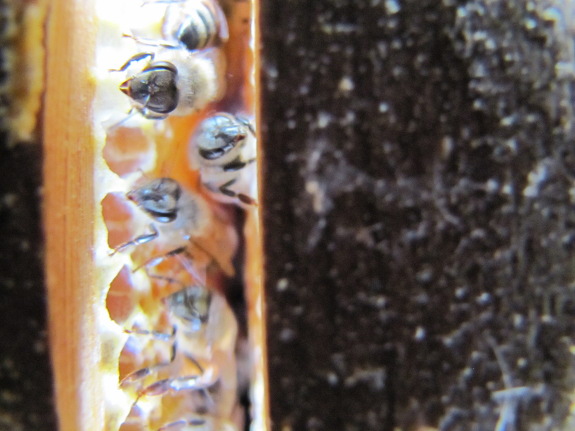
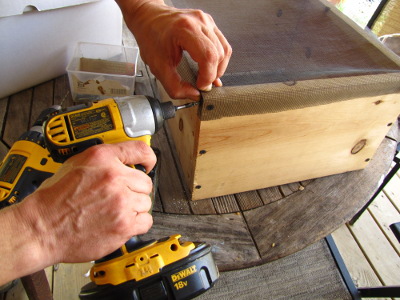 Usually, a warre hive
wouldn't be opened at all in the spring, but
the last time I delved inside, I noticed that I can't
change the water-absorbent material in the quilt without bothering the
bees because workers have gnawed through the burlap bottom. So I
opted to upgrade the quilt to include a screen bottom, which meant
taking the current quilt off to swap. (I forgot, though, that the
real issue was the burlap layer beneath the quilt --- I'll have to upgrade
that layer later.)
Usually, a warre hive
wouldn't be opened at all in the spring, but
the last time I delved inside, I noticed that I can't
change the water-absorbent material in the quilt without bothering the
bees because workers have gnawed through the burlap bottom. So I
opted to upgrade the quilt to include a screen bottom, which meant
taking the current quilt off to swap. (I forgot, though, that the
real issue was the burlap layer beneath the quilt --- I'll have to upgrade
that layer later.)
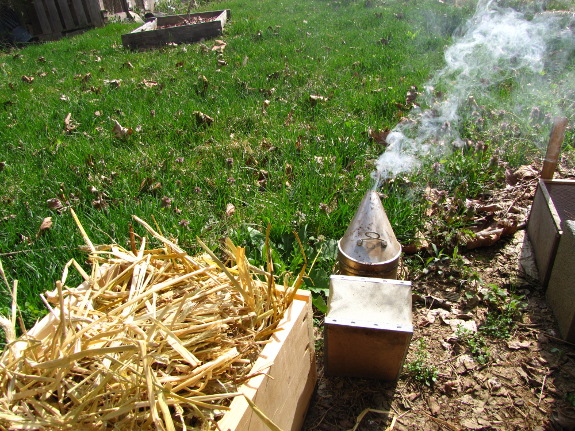
Smokers are similarly
verboten in warre hives, but I was less than pleased at the bees'
reaction to their second nadiring last year, so I decided to
go ahead and smoke lightly. After all, I was only affecting the
bees directly under the quilt since I didn't open the rest of the hive
up. With the smoker in hand, the bees were so calm I omitted
gloves and could 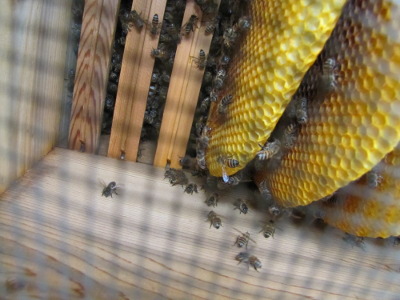 have
gotten away without any gear at all.
have
gotten away without any gear at all.
I did take a photo from
underneath and a couple down through the bars in the top box to get an
idea what's going on inside. The bottom box (of three) is showing
very little activity, but the top box looks like it's got at least some
capped honey, which is a great sign for April. The whole
structure was literally buzzing with life.
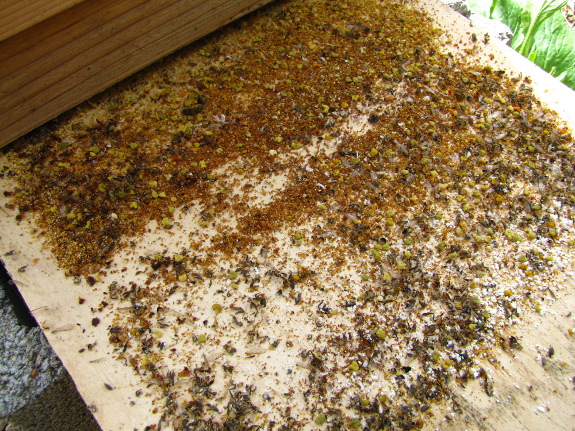
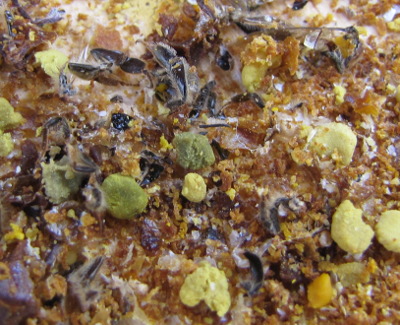 My final task at the hive was
to remove the board so that the screened bottom was once again
exposed. Quite a lot of debris had built up over the winter,
mostly bee legs, pollen clusters, and capping wax. The open
bottom will allow for much-needed ventilation over the summer, and will
also let debris like this fall to the ground, keeping diseases away
from our bees.
My final task at the hive was
to remove the board so that the screened bottom was once again
exposed. Quite a lot of debris had built up over the winter,
mostly bee legs, pollen clusters, and capping wax. The open
bottom will allow for much-needed ventilation over the summer, and will
also let debris like this fall to the ground, keeping diseases away
from our bees.
I'm still on the fence
about how to expand our apiary this year. If I don't make a
decision soon, I'll go with the obvious (but less sweet) option of
splitting this hive in May. Stay tuned for further thoughts on
the topic in later posts.
Want more in-depth information? Browse through our books.
Or explore more posts by date or by subject.
About us: Anna Hess and Mark Hamilton spent over a decade living self-sufficiently in the mountains of Virginia before moving north to start over from scratch in the foothills of Ohio. They've experimented with permaculture, no-till gardening, trailersteading, home-based microbusinesses and much more, writing about their adventures in both blogs and books.
Want to be notified when new comments are posted on this page? Click on the RSS button after you add a comment to subscribe to the comment feed, or simply check the box beside "email replies to me" while writing your comment.

Hi Anna, I just thought I'd mention a different hive system invented by Oscar Perone. He called it the automatic hive because the beekeeper doesn't have to do anything except harvest the honey. I think the main difference between the Warre and the Perone is the size - the Perone is huge. The large size creates a super-colony, which is supposed to make the hive much stronger and resilient against diseases and pests. It was explained to me that the colony is really one super-organism, rather than lots of individual bees. I am just a beginning beekeeper, but I thought I'd throw that out there since it seesm like the perfect permaculture hive and most people haven't heard of it (not a lot of info available in English, but I do have quite a bit on my blog).
Anna,
I have nowhere near your experience with bees, but I recently heard Sepp Holzer's take on bees and it was so interesting I thought i'd pass it along. Sepp does some stuff with natural log hives, with very thick walls. He basically claims that the thickness of the walls adds some insulation against rapid temperature changes that can affect bees so much. The log is on a light slope to allow for drainage, but ventilation is not desirable, especially during the winter. His idea is that the bees sanitize the air, and that if the material the hive is made out of is naturally breathable, and there is drainage, the bees will be happier. Also, he didn't recommend putting a blanket or some kind of insulator over the hive in the winter as it would shock the bees when you took it off, but he seemed ok with it assuming it was, again, a naturally breathable material.
The most interesting thing he talked about though, by far, was planting a mat of essential oil plants (lavender, rosemary, etc), that the bees have to go through to enter the hive. He felt that the bees would basically be washed of many varoa mites this way. He even went so far as to add a layer of cuttings of the herbs, wrapped in cheesecloth, above the brood.
Super interesting take on bees, I thought.